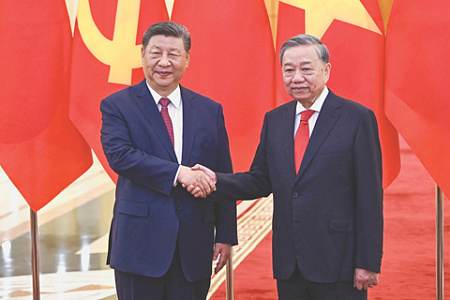
Chinese President Xi Jinping has arrived in Vietnam. Following this visit, he will visit Malaysia and Cambodia. The tour of Southeast Asian countries was undertaken against the backdrop of the tariff war launched by US President Donald Trump. Its duties hit Vietnam, Cambodia, and other Chinese neighbors, whose economies depend on exports to America, especially hard. Xi’s trip is intended to demonstrate that China, unlike the United States, is a reliable trading partner that can be trusted.
According to Reuters and Bloomberg, it was previously assumed that Xi Jinping’s first trip abroad this year was to show the region how powerful the Chinese economy is and how profitable it is to rely on it. However, the tariffs announced by Trump have changed the nature of the voyage.
Now the Chinese leader will have to convince his interlocutors not to break off the deals that have been concluded with China. This is, so to speak, a minimum program. But there is also another goal – to try to recruit neighbors, to turn them into partners in the joint opposition to American tariffs.
Xi flew to Hanoi a few days after Trump increased tariffs on Chinese goods and gave all other countries a 90-day delay in imposing tariffs. Thus, Trump wants to punish Beijing for its retaliatory action against the United States and encourage medium-sized and small Asian countries to make concessions to Washington in order to avoid its duties.
Lynette Ong, a professor at the University of Toronto, says, “The fact that Xi Jinping is visiting these three countries means a lot. This is an attempt to form alliances to fight back against the United States, which has launched a trade war.”
The Chinese leader, of course, wants to present China as a stable partner, not like America under the leadership of Trump, whose steps unnerve global markets. But his visits also highlight the vulnerable situation of Southeast Asian countries. During Trump’s first term, these countries played a major role in promoting Chinese goods in the United States. And now, seeking exemption from the duties just imposed by the United States, they are afraid that China will redirect its goods to their markets.
In an article published in the Vietnamese newspaper Nan Zan, Xi Jinping criticized protectionism and stressed that China and Vietnam should work together to protect a multipolar trading system and stable supply chains. “There are no winners in trade or tariff wars. Protectionism leads nowhere,” Xi said.
At the same time, he tried to win Vietnam over, reminding that Beijing is ready to continue building three railways between Vietnam and China. China, Xi then writes, would welcome increased sales of Vietnamese goods to China, cooperation in telecommunications and other new technologies.
Vietnamese President Toh Lam also made an article in his country’s press. He wrote that Vietnam wants to expand cooperation with China in the field of defense, infrastructure, especially in the construction of railways. Although both China and Vietnam are led by Communist parties, their economic relations are based on business principles. It is not clear from the publications in the press of both countries what financial obligations the parties assume under the agreements that are to be signed in Hanoi. And there will be about 40 agreements.
It’s really a mystery. After all, Vietnam is so dependent on exports to the United States that it cannot fully identify with China. According to TASS, by the end of 2024, the trade turnover between the two countries reached almost $ 150 billion, of which Vietnam’s exports to the United States amounted to 137 billion, an increase of 19% compared to the previous year. There is a huge imbalance: the value of Vietnamese exports to the United States is 10 times higher than the value of imports from America. Therefore, it should not be surprising that Trump’s decision to impose one of the highest tariff rates on Vietnam.
Peter Navarro, Trump’s trade adviser, has explicitly demanded that countries such as Vietnam, Cambodia, and Malaysia stop playing the role of a way station on the route of Chinese goods to the United States. This demand forces China’s neighbors to make a difficult choice: to sever ties with their largest trading partner– China, or face sanctions. Vietnam is subject to a tariff of 46%, Malaysia – 24%, Cambodia – 49%. And some of these countries are yielding to American pressure. Vietnam has announced that it will investigate cases of fraud in the transportation of goods abroad. According to experts, we are talking specifically about the supply of Chinese products to the United States through Vietnam.
These tricks are being attempted at a time when China’s economy is experiencing difficulties. Trump’s tariffs could reduce exports to the United States and force some industrial plants to close and lay off workers.
This is the problem facing Beijing. And for the countries of Southeast Asia, as stated in the publication of the Naval War College in Washington, postponing US tariffs is equivalent to postponing the estimated execution. Sooner or later, the execution will take place.
